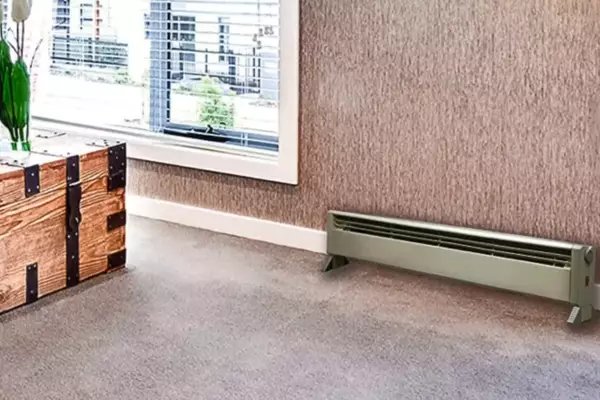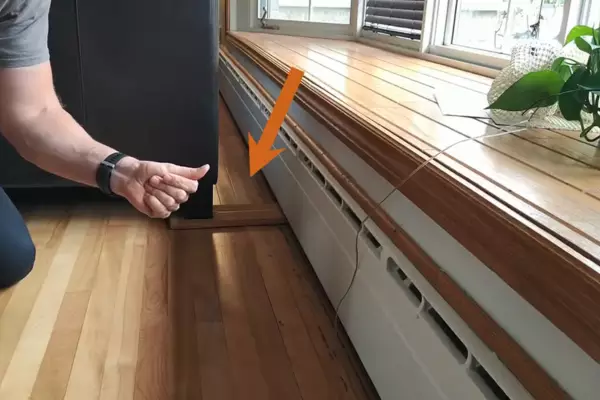Baseboard heaters have gained significant popularity for their ability to provide consistent warmth during the chilly months. These fixtures have become a crucial part of many households, promising comfort and a cozy ambiance. However, their installation often prompts a vital question related to room furnishing.
Yes, you can place furniture in front of baseboard heaters, but caution is advised. The placement should ensure a safe distance to prevent any potential fire hazards or heater functionality compromise due to obstruction. Furniture can absorb and block heat, so maintaining an optimal gap is essential for safety and efficiency.
The positioning of furniture against baseboard heaters indeed needs a tactful approach. From fire safety to maintaining the heater’s optimal performance, there are several factors to consider. The aim is to create a warm, comfortable space without jeopardizing safety or heater efficiency.
Contents
The Heat Distribution Process
Working Principle of Baseboard Heaters
A baseboard heater works on the principle of convection heating. It generates heat as electricity passes through the heater’s element, causing the surrounding air to warm up. This hot air rises and moves around the room, replaced by cooler air that gets heated subsequently, establishing a continuous cycle of warm air flow.
Distribution and Range of Heat
Due to the convection heating process, the heated air is primarily directed upward, filling the room from the top. The heat gradually circulates to other parts of the room, creating a uniform temperature. However, any obstructions in the path of this rising hot air can impede proper heat distribution and lead to potential safety concerns.

Furniture Positioning Concerns
Direct Contact Risks
Placing furniture directly against the baseboard heaters presents the risk of overheating. Furniture materials, particularly those prone to high-heat damage, can discolor, warp, or even ignite when exposed to constant heat. This direct contact can pose a serious fire hazard.
Heat Absorption by Furniture
Furniture made from materials that absorb heat can disrupt the room’s temperature equilibrium. Instead of distributing the heat evenly across the room, the furniture absorbs a significant portion, leaving other areas colder. Moreover, heat-absorbing materials may degrade over time due to consistent high temperatures.
Fire Hazard Possibility
Furniture and other items placed too close to the baseboard heaters can catch fire if they reach a high enough temperature. This is especially concerning for materials such as fabric or wood. According to the National Fire Protection Association, heating equipment is the second leading cause of home fires, underscoring the need for cautious furniture placement.
Safe Distance Regulations
Manufacturer’s Instructions
Every baseboard heater comes with a set of manufacturer’s guidelines, which typically suggest a minimum distance to maintain from the heater. These instructions should be followed diligently to ensure safety and prevent any potential damage.
Standard Safe Distance Recommendations
While the specifics may vary, a standard recommendation is to keep furniture at least a foot away from baseboard heaters. This distance is considered safe to prevent any potential fire hazard or damage to the furniture due to high heat exposure.

Material Considerations
Furniture choice plays a vital role when it comes to baseboard heaters. Not all furniture materials are created equal – some pose a risk near heaters, while others can withstand the heat.
Fire-resistant Materials
Fire-resistant or flame-retardant materials can provide added safety when placing furniture near baseboard heaters. These materials undergo a chemical treatment process that reduces their flammability. They are less likely to catch fire quickly, providing you with crucial time to react in case of an accident. Here are some common fire-resistant materials:
- Metal: It has a high melting point and does not catch fire easily, making metal furniture a safe choice. However, metal can get hot to touch and might not be suitable for households with children.
- Leather: Genuine leather has excellent heat resistance. It will not ignite easily, making leather couches, chairs, or ottomans a good choice near baseboard heaters.
- Glass: Although it’s not a common material for furniture, glass tabletops or shelves could be an excellent addition to a room with a baseboard heater. Glass withstands heat well and will not catch fire.
Furniture Material Risks
Certain furniture materials pose higher risks near baseboard heaters. They may not only catch fire but can also degrade with constant heat exposure, which can affect the look and longevity of your furniture. Some risky materials include:
- Wood: Prolonged exposure to heat can dry out the wood, making it more susceptible to catching fire. It can also cause warping, cracks, or discoloration.
- Plastic: Plastic furniture can melt or deform when exposed to high temperatures. It can also release harmful fumes when overheated.
- Fabric: Upholstered furniture or pieces with fabric covers can pose a risk if the fabric is flammable. Synthetic fabrics, such as polyester, can melt and stick to the heater, causing a potential fire hazard.
Heater Functionality Impact
Baseboard heaters need a free flow of air to function effectively. Placing furniture too close to the heater can hamper its efficiency and put additional strain on the unit.
Efficiency Compromise
When the heater’s air flow is blocked by furniture, it struggles to distribute heat evenly in the room. It can lead to:
- Higher Energy Bills: The heater will need to work harder to heat the room, consuming more energy and resulting in higher electricity bills.
- Cold Spots: Some areas in the room might remain cold due to uneven heat distribution.
Unwanted Heater Strain
The added strain on a baseboard heater due to obstructions can shorten its lifespan and cause other issues such as:
- Frequent Breakdowns: The heater may require frequent repairs due to the constant strain.
- Reduced Lifespan: A heater working under continuous stress may not last as long as it would under optimal conditions.

Alternative Placement Ideas
Designing a room layout that harmonizes the need for heat and space functionality can be challenging, but with some creativity and planning, it’s entirely possible.
Optimal Room Layouts
Consider these ideas to create a room layout that ensures effective heat distribution and maintains a safe distance from the baseboard heater:
- Create Zones: Divide your room into zones – a heating zone that’s kept clear and a living zone for furniture. Use rugs or low-profile furniture to define these areas.
- Wall-mounted Shelves: Instead of a bookcase or a cabinet, consider wall-mounted shelves that leave the floor clear for heat to circulate.
- Furniture with Clearance: Consider furniture pieces with legs that offer space underneath for the heat to pass through.
Smart Furniture Choices
Choosing the right kind of furniture can reduce the risk associated with placing them near baseboard heaters. Here are a few suggestions:
- Heat-resistant Furniture: Opt for furniture made from materials that can withstand heat.
- Lower-profile Furniture: These are less likely to block the heat from a baseboard heater.
- Modular Furniture: They offer flexibility and can be moved around or reconfigured to suit the heating needs of your room.
Additional Safety Tips
Adopting a few safety measures can prevent potential risks associated with baseboard heaters. Here’s what you can do to ensure safe heating:
Regular Heater Cleaning
Regular maintenance of your baseboard heater is crucial for its efficiency and safety. Keep these tips in mind:
- Dust Removal: Use a vacuum cleaner or a brush to remove dust and dirt that can hamper the heater’s performance.
- Seasonal Check: Before the heating season starts, ensure your heater is clean and functioning correctly.
Avoiding Flammable Materials
Keep flammable materials away from the heater to prevent accidental fires. This includes:
- Curtains and Drapes: Make sure they are short enough not to touch the heater.
- Books and Papers: Do not place bookshelves or paper stacks near the heater.
- Rugs and Carpets: Do not lay them in front of the heater as they can block the heat and pose a fire hazard.
Frequently Asked Questions
Can I place a couch in front of a baseboard heater?
Yes, but maintain a safe distance of at least one foot. The couch should not block the heater, and materials should withstand the heat without catching fire or deteriorating.
Are baseboard heaters dangerous?
No, baseboard heaters are not inherently dangerous. However, improper usage or placing flammable objects too close can pose a fire hazard.
Can I cover my baseboard heater?
Covering a baseboard heater is not recommended as it can obstruct the heat flow, reduce efficiency, and increase the risk of fire.
Conclusion
The crux of the matter remains that while placing furniture in front of baseboard heaters is feasible, it necessitates caution. Maintaining the recommended distance and choosing heat-friendly furniture can help ensure safety without compromising on heater efficiency.
Every household seeks to create a warm, inviting space, especially during winter. And it’s achievable without putting one’s safety at stake. With tactful furniture positioning and adherence to safety guidelines, one can enjoy the warmth of baseboard heaters while ensuring a well-furnished, aesthetically pleasing living space.
Ultimately, the comfort of a cozy room should not compromise safety and heater functionality. The balance of both factors will make baseboard heaters a cherished addition to your home, providing consistent warmth in a safe, controlled manner.

